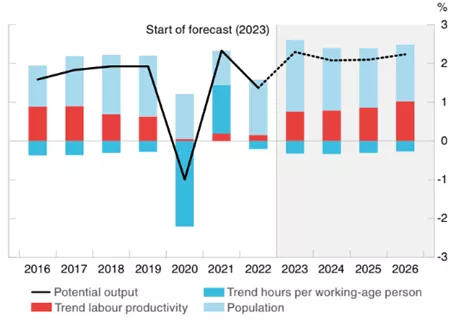The Bank Of Canada Sets The Bar Way Too Low When It Comes To Economic Performance
Photo by Rene Baker on Unsplash
Appearing before a Parliamentary committee on finance, Governor Tiff Macklem of the Bank of Canada stressed that the current forecast anticipates growth for 2023, but barely above zero. Macklem told the committee that:
“We expect growth to be small positive, so less than 1 percent but above zero... But it is going to be slight growth, which I think most people would call a soft landing.”
It was his way of claiming that Canada will avoid a recession, a condition that many economists believe will likely unfold later this year. The debate regarding whether a recession is baked into the economy already is somewhat sterile. Rather, we should be looking at economic growth per capita. Canada’s economic performance is substandard when measured on the basis of GDP per capita. Canada’s growth is coming, almost, exclusively from population expansion, fuelled by ever-annual higher immigration flows. So, a total growth rate of less than 1%, when all that growth is dependent on population expansion, hardly qualifies for any victory lap.
Canada tops the G-7 list of countries in population growth. Canada's population surged by a record 2.7%, or an additional one million, in 2022. Canada accepted 437,000 immigrants and the number of non-permanent residents increased by a net of 607,800 people. Both figures are the highest levels on record and reflect higher immigration targets and a record-breaking year for the processing of immigration applications. The Federal government has already set in motion to receive from 450,000 to 500,000 new immigrants in 2023, so we should expect population growth to surpass the one million mark again in 2023, just based on immigration and the continued retention level of non-permanent residents.
Figure 1 Sources of Potential Growth

Source: Bank of Canada, Monetary Policy Review
The accompanying chart, prepared by the Bank, separates the components that go into determining potential GDP. There are three basic components that add up to a country’s potential. First, is the trend in labor productivity or efficiency; second, is the trend in hours worked; and, third are measures related to employment, especially population growth.
Clearly, the Bank leans heavily on continued population expansion to maintain economic expansion. But economists have long argued that it is productivity growth allows for a rise in living standards, often measured in GDP per capita. As the chart indicates, our productivity performance was very poor in the past 5 years, and the projections, although better, remain weak---less than 1% annually. So, we will continue to record lackluster economic growth, largely supported by population growth, rather than productivity growth, so vital to rising standards of living.
More By This Author:
Monetary Contraction Is Now In Full Force In CanadaCanadian Bond Investors Are Totally Disconnected From The Bank Of Canada
Does The Bank Of Canada Protest Too Much About An Overheated Economy?
Disclosure: None.




